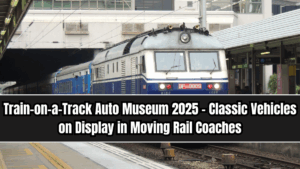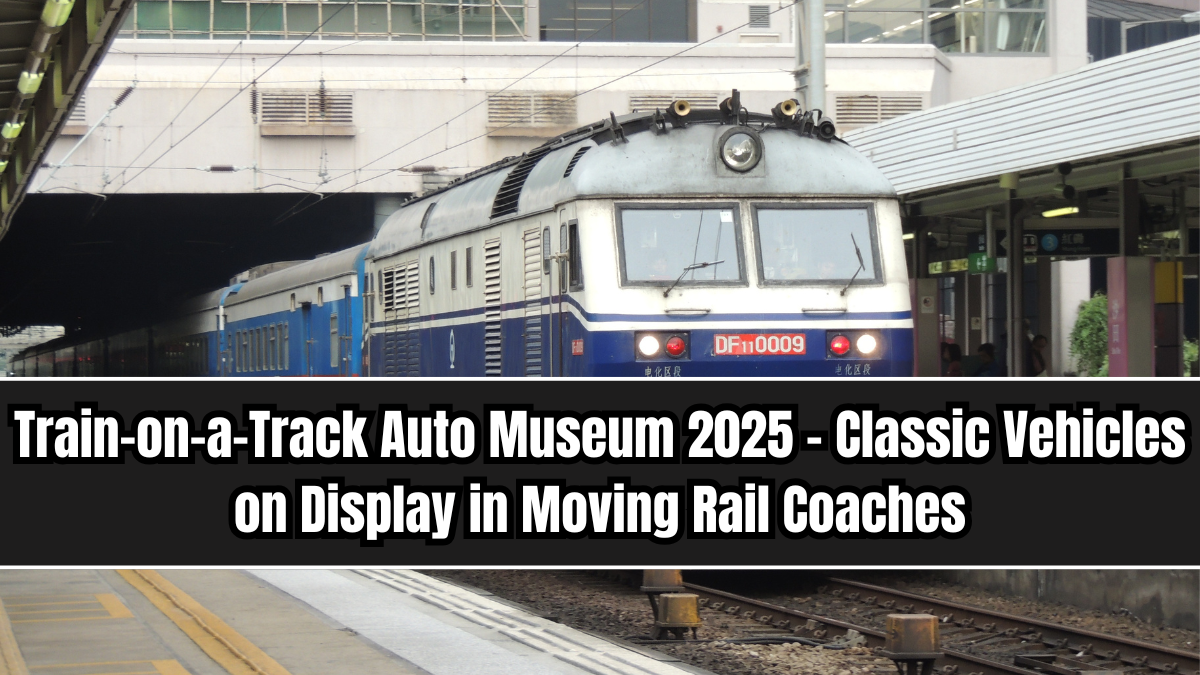India has long been a country where railways and roadways define the rhythm of travel. In 2025, the government has combined these two iconic modes of transport in a creative way by unveiling the Auto Museum Train 2025. This one-of-a-kind initiative transforms refurbished railway coaches into moving museums that display classic and vintage cars as the train travels across the country.
The project is more than just a celebration of automobiles—it is a tribute to India’s transport legacy, a boost to cultural tourism, and an innovative way to engage younger generations with history.

A Museum on Rails
The Auto Museum Train 2025 reimagines railway coaches as exhibition halls on wheels. Each coach is carefully redesigned to host restored vintage cars, complete with informative displays, interactive touch screens, and ambient lighting to enhance the viewing experience.
As the train travels from city to city, it carries with it a rolling exhibition of automotive history, making heritage accessible to millions without requiring them to visit static museums.
What Visitors Can See
The train features a curated collection of cars representing different eras and milestones in India’s automotive journey. Among the highlights are:
-
Pre-independence vehicles once owned by royal families and zamindars.
-
Post-independence Indian classics like the Hindustan Ambassador and Premier Padmini.
-
Imported luxury cars from the 1960s and 70s, showcasing global design trends.
-
Rare prototypes and concept cars that were never mass-produced but remain significant.
Each car is displayed with detailed information about its design, history, and cultural impact, turning the exhibition into both an educational and nostalgic experience.
Why a Train?
Using a train as the medium for this museum is symbolic and practical. Railways themselves are part of India’s heritage, and combining them with vintage automobiles creates a dual narrative of transport history.
Moreover, a moving museum ensures that rural towns and smaller cities—often left out of cultural initiatives—get to experience the exhibition. The train stops at multiple stations, where visitors can board and explore the collection, turning railway platforms into cultural hotspots.
Educational Value
The Auto Museum Train 2025 is not just entertainment—it has strong educational goals. School trips and college excursions are being organized to allow students to learn about:
-
The evolution of automobile engineering.
-
The role of cars in India’s socio-economic development.
-
Heritage conservation and restoration techniques.
Interactive features, such as virtual reality stations inside the coaches, let children experience driving vintage cars in a simulated environment. This blend of tradition and technology makes the museum engaging for all age groups.
Tourism and Economic Impact
Tourism boards expect the Auto Museum Train to become a major attraction, drawing car lovers, history enthusiasts, and families. By moving across states, the train brings tourism revenue to multiple regions instead of being limited to a single city.
Local businesses around the train’s stopovers—cafes, handicraft sellers, and transport providers—benefit from increased footfall. Additionally, railway stations themselves see renewed cultural significance as they host the exhibition.
Preserving Heritage Through Innovation
Classic cars are often locked away in private collections, unseen by the public. The Auto Museum Train democratizes access by putting them on display for all. Restoration workshops linked with the project are also training a new generation of mechanics and craftsmen skilled in vintage car conservation.
The initiative reflects India’s growing commitment to preserving cultural heritage while making it dynamic and accessible. Instead of confining history to closed halls, the museum travels where the people are.
Looking Ahead
The success of the Auto Museum Train could inspire future expansions, such as:
-
Themed coaches (royal cars, racing cars, military vehicles).
-
International collaborations, showcasing foreign heritage cars alongside Indian ones.
-
Digital AR/VR tours, allowing global audiences to virtually explore the train.
-
Merchandise and memorabilia stalls, creating an additional tourism market.
There are also discussions about linking the museum train with heritage railway rides, where visitors could enjoy classic cars at the station before boarding a vintage locomotive journey.
Final Thoughts
The Auto Museum Train 2025 is more than just a collection of cars—it is a moving celebration of history, culture, and innovation. By combining the power of railways with the allure of classic automobiles, India has created an experience that is both educational and entertaining.
For car enthusiasts, it is a chance to witness rare vehicles up close. For families, it is a memorable outing. For the nation, it is a proud showcase of its transport heritage, traveling across states and generations.
As the train glides through the tracks carrying these timeless machines, it symbolizes a journey where past and present ride together into the future.
FAQs
What is the Auto Museum Train 2025?
It is a unique moving museum in India that displays classic and vintage cars inside refurbished railway coaches.
Why use a train for the museum?
A train allows the exhibition to travel across multiple states, making heritage accessible to both urban and rural communities.
What types of cars are displayed?
The collection includes royal pre-independence cars, Indian classics like the Ambassador, imported luxury cars, and rare prototypes.
Is the museum interactive?
Yes, visitors can access digital displays and VR experiences, making it engaging for students and families.
How does the project benefit tourism?
It attracts tourists across cities, boosts local businesses near stations, and adds cultural value to railway hubs.
Who manages the Auto Museum Train?
The initiative is a collaboration between government heritage boards, railway authorities, and private car collectors.
Will the museum expand in the future?
Plans include themed coaches, AR/VR tours, and international collaborations to make the experience even richer.
Click here to know more.
